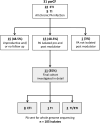Impact of CFTR Modulation on Pseudomonas aeruginosa Infection in People With Cystic Fibrosis
- PMID: 38442240
- PMCID: PMC11420785
- DOI: 10.1093/infdis/jiae051
Impact of CFTR Modulation on Pseudomonas aeruginosa Infection in People With Cystic Fibrosis
Abstract
Background: Pseudomonas aeruginosa is a multidrug-resistant pathogen causing recalcitrant pulmonary infections in people with cystic fibrosis (pwCF). Cystic fibrosis transmembrane conductance regulator (CFTR) modulators have been developed that partially correct the defective chloride channel driving disease. Despite the many clinical benefits, studies in adults have demonstrated that while P. aeruginosa sputum load decreases, chronic infection persists. Here, we investigate how P. aeruginosa in pwCF may change in the altered lung environment after CFTR modulation.
Methods: P. aeruginosa strains (n = 105) were isolated from the sputum of 11 chronically colonized pwCF at baseline and up to 21 months posttreatment with elexacaftor-tezacaftor-ivacaftor or tezacaftor-ivacaftor. Phenotypic characterization and comparative genomics were performed.
Results: Clonal lineages of P. aeruginosa persisted after therapy, with no evidence of displacement by alternative strains. We identified commonly mutated genes among patient isolates that may be positively selected for in the CFTR-modulated lung. However, classic chronic P. aeruginosa phenotypes such as mucoid morphology were sustained, and isolates remained just as resistant to clinically relevant antibiotics.
Conclusions: Despite the clinical benefits of CFTR modulators, clonal lineages of P. aeruginosa persist that may prove just as difficult to manage in the future, especially in pwCF with advanced lung disease.
Keywords: Pseudomonas aeruginosa; CFTR modulators; ETI; cystic fibrosis; elexacaftor-tezacaftor-ivacaftor.
© The Author(s) 2024. Published by Oxford University Press on behalf of Infectious Diseases Society of America.
Conflict of interest statement
Potential conflicts of interest . All authors: No reported conflicts. All authors have submitted the ICMJE Form for Disclosure of Potential Conflicts of Interest. Conflicts that the editors consider relevant to the content of the manuscript have been disclosed.
Figures




References
MeSH terms
Substances
Grants and funding
LinkOut - more resources
Full Text Sources
Medical

